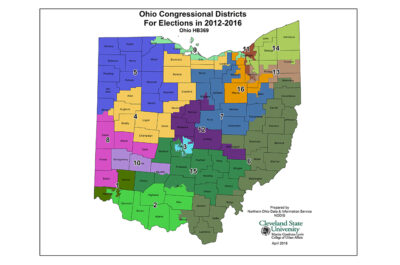
Huffman v. Neiman
What's at Stake
This case asks whether the Elections Clause of the U.S. Constitution bars the Ohio state court from enforcing redistricting requirements in the Ohio constitution that prohibit partisan gerrymandering.
Summary
In 2018, Ohio sought to end partisan gerrymandering by amending its state constitution. The legislature adopted, and Ohioans approved by a margin of 75% to 25%, a ballot measure that prohibits the simple majority passage of a congressional district plan that “unduly favors or disfavors a political party or its incumbents.”
Under Article XIX, the state legislature may adopt a 10-year congressional district plan if that plan has bipartisan support. If the legislature is unsuccessful in passing a bi-partisan plan, the legislature may pass a four-year plan with a simple majority of votes in each house.
In 2021, the Ohio legislature undertook congressional redistricting based on new decennial census data. The Ohio legislature was unable to pass a bi-partisan 10-year plan, and instead passed a 4-year plan along party lines. The plan positioned the Republican party, which generally wins no more than 55 percent of the popular vote in Ohio to reliably win between 75 and 80 percent of the congressional seats in Ohio.
The ACLU challenged the congressional plan in Ohio Supreme Court We argued that it unduly favors the Republican Party in violation of Article XIX. The Ohio Supreme Court agreed, and invalidated the plan as an unconstitutional partisan gerrymander. The court directed the state legislature to draw new maps.
Instead of drawing a new compliant map, Ohio is seeking certiorari from the U.S. Supreme Court. The state argues that because the Elections Clause of the U.S. Constitution authorizes the state legislature to adopt rules for congressional elections, it prohibits the Ohio Supreme Court from enforcing the Ohio Constitution in reviewing the Ohio legislature’s congressional plan.
The ACLU opposes certiorari because the state legislature referred to by the Elections Clause cannot be separated from the state constitution that creates, defines, and constrains it. It is state courts’ role to interpret its own state constitution. Where, as in Ohio, the state legislature itself expressly authorized the state court to enforce state constitutional limits on the power of state legislatures to regulate congressional elections, the Elections Clause permits state courts to carry out that function. Here’s the Ohio Supreme Court properly interpreted the Ohio constitution ban on partisan gerrymandering and struck down the state legislature’s excessively partisan congressional maps.
After its ruling in Moore v. Harper, the Supreme Court instructed the Ohio Supreme Court to reconsider a previous ruling that required Ohio’s congressional map be redrawn over unconstitutional partisan gerrymandering.
Following its routine practice when cases it decides overlap with cases before it on a petition for certiorari, the U.S. Supreme Court “granted, vacated, and remanded,” asking the state court to consider its decision in light of the high court’s recent ruling in Moore v. Harper, which rejected the “independent state legislature” theory.
Legal Documents
-
12/30/2022
Reply Brief of Petitioners -
12/19/2022
Brief of Neiman Respondents in Opposition -
12/19/2022
Brief of League of Women Voters of Ohio in Opposition -
10/14/2022
Petition for Writ of Certiorari
Date Filed: 12/30/2022
Court: Supreme Court
Download DocumentDate Filed: 12/19/2022
Court: Supreme Court
Download DocumentDate Filed: 12/19/2022
Court: Supreme Court
Download DocumentDate Filed: 10/14/2022
Court: Supreme Court
Download DocumentPress Releases
ACLU Comment on U.S. Supreme Court Action in Ohio Partisan Gerrymandering Case

